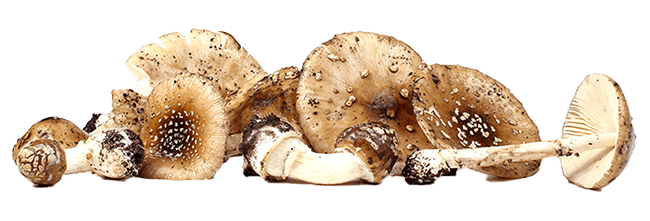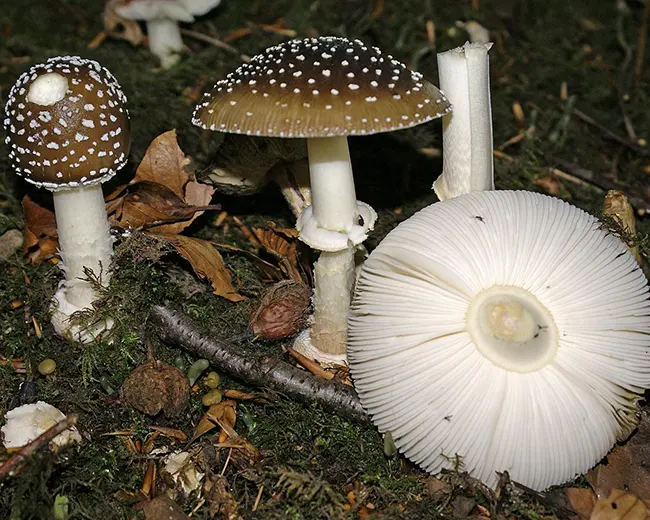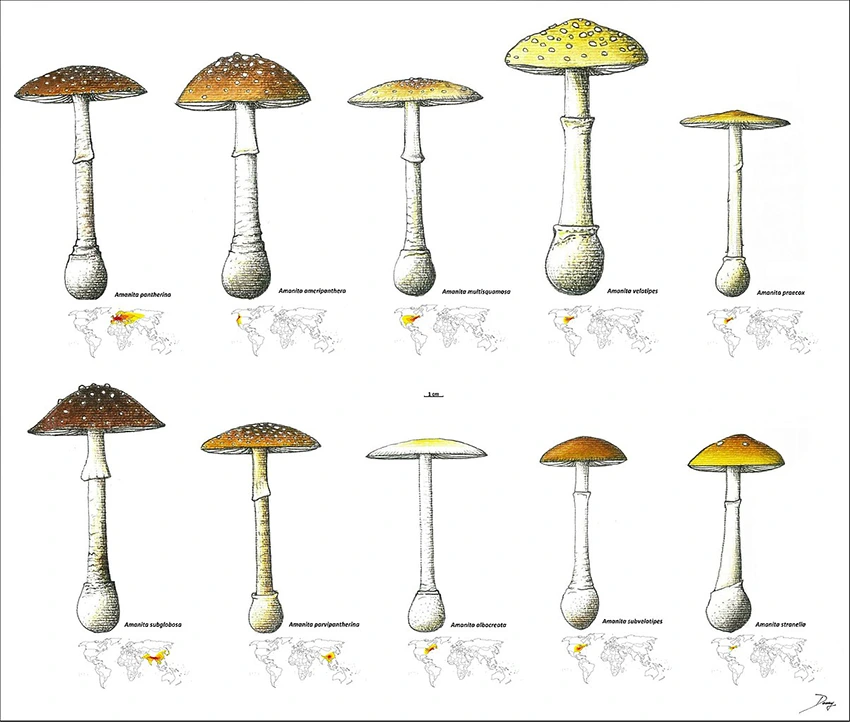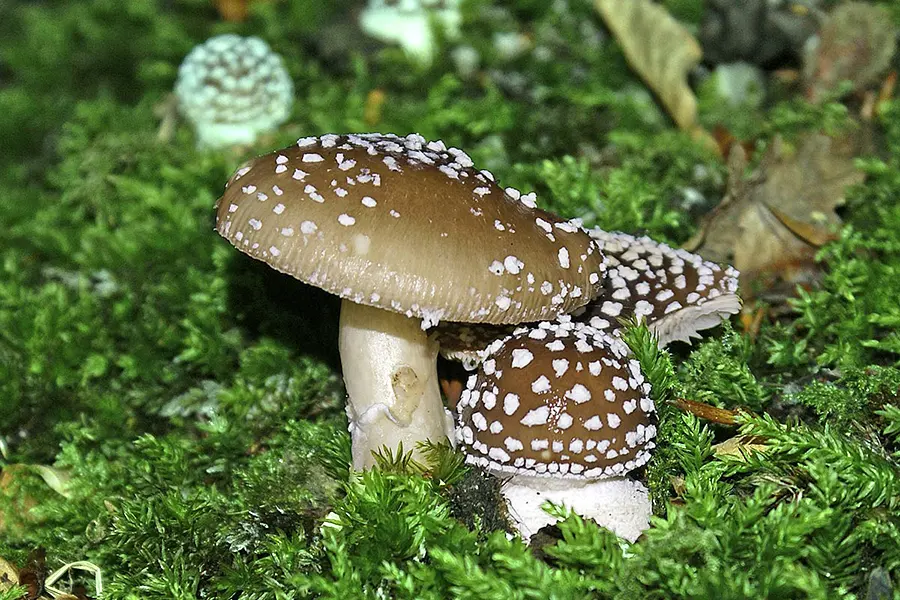The Fly Agaric (Amanita muscaria) mushroom carries significant cultural mystique. It’s one of the most recognizable mushrooms and also one of the most well-known entheogens. Entire books delve into the various theories about its use and the subsequent cultural implications. Even children’s stories allude to its magical properties. But did you know that some related mushroom species also contain the same psychoactive compounds? The Panther Cap (Amanita pantherina), with its brown cap with white warts, is often overshadowed by its bright showy relative. The Panther Cap is mysterious—little is said about it other than as a passing aside. But, the potent mushroom has as many reasons to merit discussion.
Meet the “Panther Cap” Mushroom (Amanita pantherina)
The Fly Agaric—the more famous relative to the Panther Cap—is as equally admired as it is hated. The iconic “toadstool” mushroom carries a considerable mycophobic heritage; it’s been dubbed toxic, as poisonous. Children and adults alike will kick and smash the mushroom with their boots without reparation. Yet it is equally revered—it adorns clothing and sprawls across coloring book pages. The curiosity around the Fly Agaric has experienced a renaissance in modern years. The conversation has the benefit of new eyes. It’s a conversation that is critical of past narratives, putting to rest generations of mycophobia, and reinvestigates what benefits this mushroom may hold. And while we may be somewhat familiar with A. muscaria, the archetypal “fairy mushroom,” we are less familiar with Amanita pantherina, the “Panther Cap.” To learn about the Panther Cap, we also have to learn about the Fly Agaric, as the two seem so closely intertwined.
In recent years, the narrative around Amanita muscaria has changed significantly. The fear and superstition surrounding this mushroom—and, by virtue, its lesser-known relative Amanita pantherina—is ebbing away. But is this change also representative of market forces reflecting an over-enthusiastic community? It is recommended that the Fly Agaric and Panther Cap be treated with caution and respect, with due diligence in research before any use. There is also a developing market of Amanita powders, tinctures, and gummies, of fake products that promise powerful experiences and “ego death” more suggestive of psilocybin experiences rather than muscimol. Muscimol is the active component in psychoactive amanita mushrooms. Psilocybin is a component in other mushrooms.
Safety Note
Muscimol is NOT psilocybin. Muscimol is a powerful and often dangerous deliriant that can place consumers into a coma-like sleep in high doses. It can cause dissociation, agitation, and a loss of rational thought, inspiring people to act in ways that otherwise might not. Hallucinogenic Fly Agaric mushrooms increase the risk that someone may pose harm to themselves. It is not recommended to take this mushroom in high doses or take this mushroom alone. Find the US poison control hotline here: +1-800-222-1222
Amanita pantherina (DC. ex Fr.) Krombh. (1846) is a basidiomycete fungus from the genus Amanita, one of the oldest genera of gilled fungi with species found on every continent except Antarctica. Like most Amanita species, the panther cap is ectomycorrhizal: They grow symbiotically with certain tree species. The trees share carbohydrates in return for nutrients and potentially other environmental signals from Amanita mycelium, “wood wide web.”
The panther cap was scientifically named by Swiss-born mycologist Augustin Pyramis De Candolle, who formally described the species in 1815 using specimens from France and Germany, naming it Agaricus pantherinus. The specific epithet “pantherina” and the common name “Panther Pilz” (or “Panther Cap”) both refer to the brown-and-white spotted appearance of the cap of this mushroom, which bears a resemblance to the two-tone coat of a Panther. In 1846, the German mycologist Julius Vincenz von Krombholz moved the panther cap to its present genus, solidifying the name “Amanita pantherina”. Given its wide European distribution, A. pantherina is known by numerous colloquial names including, but not limited to, false blusher, panther cap, the panther, panther agaric, grapaoudin, pantera, pantherschwamm, krôtenschwamm, and in Japan as tengutake.

Amanitas in Popular Culture
Amanita pantherina does not seem to be mentioned in the myths and fairy stories of old in quite the same way as the Fly Agaric. There are hints of red and white throughout numerous cultures—from India, Tibet, the Middle East, Europe, and the colder Scandinavian countries. It has been suggested that use of Fly Agaric goes so far back into history that mythological fragments and remembrances may taint stories or even indicate rediscoveries at later times—most notably the reinterpretation of Christian or Renaissance paintings in an effort to imply entheogenic use.
How to Grow Shrooms Bundle
Take Both of Our Courses and Save $90!
References to A. muscaria began in 1730 with Filip Johann von Strahlenberg, with the publication of an account of the use of the mushroom by the Koryaks of the Kamchatka Peninsula. The report was corroborated first by Stepan Krasheninnikov in 1755 and then by Georg Wilhelm Steller in 1774. During the 1800s, there was wide interest in a variety of psychoactive plants and compounds, including A.muscaria. The so-called “narcotic” effects of the Fly Agaric were reported in books such as “The Seven Sisters of Sleep” by Mordecai Cubitt Cooke—allusions to the mushroom in Lewis Carroll’s “Alice in Wonderland” were inspired by Cooke’s book—and later in “Phantastica” by Lewis Lewin.
READ: The Trippy Truth About Amanita muscaria, The World’s Most Famous Mushroom

The Fly Agaric has been implicated in fertility cults associated with Jesus Christ1—as well as the origins of Santa Claus. More recently, A. muscaria is represented in the Mario franchise as a “power-up” mushroom, giving Mario an energetic boost. It also shows up figuratively in the houses of the Smurfs. The brown-capped pantherinas don’t seem to carry quite the same mystique. There is no brown pantherina emoji; you don’t often find it printed on reusable grocery bags. Still, there is one myth worth mentioning.
Pantherina seem to be implicated in the narrative around a particular brand of battle-hardened Viking and their willingness to dive into battle in their full naked glory in pursuance of Valhalla. In 1968, Gordon Wasson published “Soma: Divine Mushroom of Immortality,” in the introduction, he refers to a book by Professor Carl T. Morner, ‘On the Higher Mushrooms’ in which Morner discusses A. muscaria and A. pantherina referring to other literature claiming that the Berserkers of Scandinavia knew how to use Amanita species to put themselves in a suitably battle-ready mood. Of further interest is a reference to a regiment of soldiers in 1814, with a Swedish officer having noticed that some of the men were ‘raving’ and foaming at the mouth. To quote: “An investigation revealed that these soldiers had eaten Amanita in order to be in proper fighting fettle!”
By the end of the 60s, both scientific and ethnobotanical research had been gathered, with various researchers discussing the ethnopharmacology of both A. muscaria and A. pantherina in the context of both ancient and contemporary use. The published proceedings from the Ethnopharmacologic Search for Psychoactive Drugs Symposium in San Francisco in 1967 had a whole segment dedicated to A. muscaria. 1968 saw the publication of Gordon Wasson’s book “Soma: Divine Mushroom of Immortality,” in which he proposed that A. muscaria was the Hindu deity Soma, mentioned in the ancient Hindu text the Rig Veda.
What Do Panther Cap Mushrooms Look Like?
In order to identify any mushroom, it is important to take note of all the features for identification: the cap, stem, and gills, including their colour and texture. Amanita pantherina lacks the bright colour of its more recognizable relative, but the two share many other features. Because the panthercap has many look-alikes, it is important to take careful note of all the features, and it is recommended to follow up with an ID group or iNaturalist is highly recommended.
The pileus (cap) of A. pantherina can be deep brown to hazel brown, fading to light brown, or a pale ochraceous brown, with densely distributed warts that are pure white to cream. They are typically between 2.5–18 centimeters wide, round, initially hemispheric, then convex. The cap tends to flatten out as they get older, sometimes slightly upturned. The cap is smooth and sticky when wet; the margin is darker in color, sometimes yellowish brown, with fine radial lines. The lamellae (gills) are free to adnexed—that is, they either don’t attach to the stem at all, or they do so only slightly. The gills are whitish, becoming lightly grey with age; their spacing is close to crowded.
Many Amanita grow from an egg-shaped structure, and as the cap expands, the outer layer or “universal veil” ruptures, and in some species, fragments remain on the cap as white or cream-coloured warts. In some cases, rain can wash away the warts before the cap has fully expanded. A second structure, the partial veil, protects the gills during development and falls away to form a persistent annulus, or skirt, attached to the stem often with a ragged or toothed edge. Like most Amanita, A. pantherina has a white spore print.
The stipe (stem) is white, darkening slightly with age. It grows between 5–18 centimeters high and 1–3 centimeters thick, narrowing upward from the roundish basal bulb. The stem is fibrous, with the surface consisting of fine woolly tufts, the stipe becoming smooth above the annulus. The basal bulb is white, usually with a collar-like volva as a rim at the apex of the bulb, sometimes also with scaly or ragged zones just above the base as concentric bands that become grey with age. The flesh of the mushroom is white and does not change color when damaged. The odor can be said to be unpleasant or resemble raw potatoes.
Where is Amanita pantherina Found?
Amanita pantherina is a temperate species from Europe and western Asia. Unlike its relative, A. muscaria, the panther cap is an uncommon mushroom. It is an ectomycorrhizal species and grows in association with deciduous trees, especially beech, oaks, chestnuts, birches, and, less frequently, coniferous woodland such as Pinus spp. and Douglas Fir (Pseudotsuga menziesii). Rarely, you’ll find it in meadows in late Summer and Autumn. As a result of the commercial cultivation of various ornamental trees, A. pantherina has been introduced to many countries.
A couple of varieties of A. pantherina are recognised: A. pantherina var. Pantherina (the main variety of A. pantherina, the “European Panther”), and the “Fir-Loving Panther” A. pantherina var. abietinum. New genetic research has shifted species around a little, and through revision based on molecular techniques, we now know that species once thought to be A. pantherina are now thought to be species in their own right, only some of which have been described. We now know that species of A. pantherina found from the Rocky Mountains to the West Coast are not A. pantherina but are now referred to as Amanita pantherinoides and, while rare, are known to occur in the eastern part of the U.S. Amanita pantherina var. multisquamosa, is now known as A. multisquamosa. We also now know that species in Japan thought to be panther cap are likely to be A. ibotengutake, differing by being a larger-sized mushroom, rings ascending from the base of the stipe, and a deciduous annulus.
As ectomycorrhizal fungi, fly agaric and panther caps cannot easily be cultivated. Normally, these species are foraged within pine or birch forests or plantations. It is important to note that If you are foraging for this species, it is recommended to check your local laws about foraging and find out where it is legal for you to forage, as there may be restrictions in place. Keep in mind collecting on any private land requires the owner’s permission.

A. pantherina Look-alikes
The spotted caps of Amanita spp. are fairly distinctive, and species with brown caps are relatively common so A. pantherina potentially has a LOT of look-alikes. Species within the genus Amanita that bear a resemblance are:
- Amanita rubescens is an edible species known as “the blusher”. It has a reddish-brown cap with small white-to-mahogany warts. It lacks the rimmed bulb, and bruises reddish.
- Amanita excelsa var. spissa has a brown or brown/grey cap, with grey veil remnants often as quite large, flat patches. The margin of the cap has no radial lines.
- Amanita gemmata has a dull creamy yellow to golden yellow cap with white warts that are usually flimsy and easily washed away by rain. It typically lacks a well-defined margin on the bulb.
- Amanita multisquamosa is smaller, with a more slender stalk and whitish cap.
- Amanita velatipes is a taller, robust species with a dull yellow cap with a brownish center and many whitish warts. This species has a distinctive stem base that is ringed with a collar and sometimes concentric rings.
It is worth keeping in mind that the “warts” can get washed off in the rain, which may cause confusion and complicate identification.
Is Amanita pantherina hallucinogenic? Panther Cap Effects and Pharmacology
In most field guides, both A. muscaria and A. pantherina are referred to as poisonous and inedible. This is despite written descriptions of both cultural and culinary use of both mushrooms by prominent mycologists and ethnomycologists. The debate has been considerable and ongoing over the years, with the effects of the mushrooms being referred to as “pantherine” poisoning syndrome and as a central nervous system dysfunction.
But there is some background to the contentions. A significant part of the issue is that there was confusion over the psychoactive compounds. The highly toxic compound muscarine was described in 1869 and thought to be the hallucinogenic compound present in the mushroom. The isoxazole alkaloid Ibotenic acid and its decarboxylated product, muscimol, were not known to be the main psychoactive compounds till 1964. Ibotenic acid is the prodrug of muscimol. As the mushroom dries, ibotenic acid decarboxylates—breaks down—to form muscimol, hence the often cited caveat about the need to dry the mushrooms before consuming.
Ibotenic acid is the cause of the symptoms of “pantherine” poisoning. The syndrome is produced by the body’s efforts to process ibotenic acid. Loss of muscular control may be pronounced. There are no studies to determine the levels of toxicity or long-term effects of ibotenic acid. A. muscaria are technically poisonous (keeping in mind that alcohol is poisonous), and it can be safely consumed in controlled doses.
Ibotenic acid is an agonist of the N-methyl-D-aspartate (NMDA) receptors, given that it is structurally related to the neurotransmitter glutamate, causing dissociative effects. A psychoactive dose is regarded as 50 to 100 mg. But, it’s important to note: ibotenic acid is classified as a potent neurotoxin. This classification comes from direct application to rat brains in animal studies, not through any other use.
Warning
Dosing hallucinogenic Amanita mushrooms is notoriously difficult, as individual mushrooms each produce inconsistant concentrations of muscimol. While amanita products are available online and in stores, it’s important to preference the lowest possible dose if you choose to engage with this mushroom.
Muscimol is an agonist of GABA receptors, acting as a neurotransmitter for GABAA producing a depressant effect and effects such as visual distortions/hallucinations, loss of balance, slight muscle contractions, and altered sensory perceptions. The psychoactive dose of muscimol is estimated to be in the range of 10–15 mg and is five to six times more potent than ibotenic acid.
How to Grow Shrooms Bundle
Take Both of Our Courses and Save $90!
High doses of Amanita mushrooms can produce a long, difficult, and sometimes dangerous trip.
Drowsiness is experienced 30–60 minutes after ingestion of the mushroom. This is followed by a state somewhat resembling alcoholic intoxication, and then a hyperactive state of confusion, muscular spasms, delirium, and visual hallucinations occurs, lasting as long as four hours. Vomiting usually does not occur. A deep sleep follows.
Amanita pantherina Dosage—How Much is Too Much?
Pantherina mushrooms are rumored to be more potent than their muscaria counterparts. But, because hallucinogenic Amanitas were branded poisonous for so long, we have little confirmed information about their dose-dependent effects. Further, many amanita gummies and nascent amanita products available on the market are not standardized; it can be difficult to tell how much muscimol and ibotenic acid you’re consuming unless the product publishes lab testing and dosage values on its website or on the product label.
It can be difficult to tell how much muscimol and ibotenic acid you’re consuming unless the product publishes lab testing and dosage values on its website or on the product label.
A psychoactive dosage of muscimol is considered 8 to 15 milligrams. One gram of Amanita muscaria mushroom can contain that much. A. pantherina is more potent, perhaps up to three times as potent—therefore, it requires less to reach the same amount of active constituents. However, the potency of mushroom products varies significantly depending on environmental and circumstantial factors. Therefore, there is no way to tell how much active compound you’re eating, which makes engaging with pantherinas highly risky. Early research suggests that mushroom caps and stems contain different concentrations of ibotenic acid and muscimol, with caps containing higher concentrations.
The potency of mushroom products varies significantly depending on environmental and circumstantial factors. Therefore, there is no way to tell how much active compound you’re eating, which makes engaging with pantherinas risky.
In Germany, A. muscaria is available in pharmacies as a homeopathic tincture called “Agaricus muscarius.” It’s sold as a 100mL tincture derived from 0.35 grams of fresh mushroom. The effect of the tincture may be increased by heating it twice for three minutes until boiling: This decarboxylates most of the ibotenic acid to muscimol. A. muscaria tinctures have been used to treat depression, “mental weakness,” epilepsy, Parkinson’s disease, menopausal flushes, tics, and paresis of the bladder, amongst other uses.
Legality
In the United States, neither A. muscaria nor A. pantherina are listed as controlled substances under federal law, but some states have laws that regulate their use. For example, in California, possession of A. muscaria is legal, but it is illegal to sell or transport it for sale. In Minnesota, A. muscaria is classified as a Schedule I controlled substance, meaning it is illegal to possess or use. In Louisiana, except for ornamental purposes, growing, selling, or possessing A. muscaria is prohibited by the Louisiana State Act.
A. muscaria and A. pantherina are legal in most countries. It is, therefore, easier to list the countries where they are not legal. These include Australia, Romania, The Netherlands, and Thailand. In Thailand, Thai law includes hallucinogenic mushrooms in the Five Categories of drugs.
In Australia, muscimol is listed as a Schedule 9 prohibited substance under the Poisons Standard (the SUSMP). A Schedule 9 substance is one “which may be abused or misused, the manufacture, possession, sale or use of which should be prohibited by law except when required for medical or scientific research.
Where to from here ….
Given the overwhelming narratives of caution and fear that have surrounded many Amanita, “amanitaphobia” is still alive and well and, given the effects of some compounds that are present, in some cases, well-deserved.
- In 1970, John Marco Allegro published his book “The Sacred Mushroom and the Cross,” in which he argued that early Christian groups were a fertility cult that consumed A. muscaria as their sacrament. The hypothesis has been mostly debunked, but some still cite Allegro for the claim: “Jesus Christ was a mushroom!” For an excellent, easy-to-read analysis of Wasson and Allegro, Andy Letcher’s book “Shroom: A Cultural History of the Magic Mushroom” is highly recommended ↩︎
Disclaimer
Consume at your own risk. Amanita mushrooms are—in many ways—more dangerous than psilocybin mushrooms. Never eat them alone, and always consume with the utmost caution. This article is intended for educational purposes and should not be used in place of medical advice. DoubleBlind does not advocate participating in illicit activities. Always consult your local drug laws before engaging with any illicit substance.
In the event of an emergency, please dial local emergency services. For substance abuse help in the U.S., please dial the Substance Abuse and Mental Health Services Administration National Helpline at +1 (800) 662-4357.
Interested in having a psychedelic experience, but don't know where to start? Get our definitive guide on trusted legal retreat centers, clinical trials, therapists, and more.



